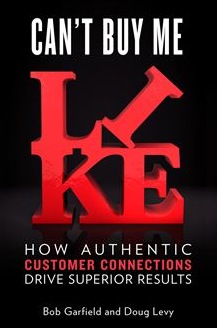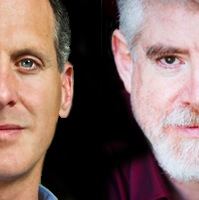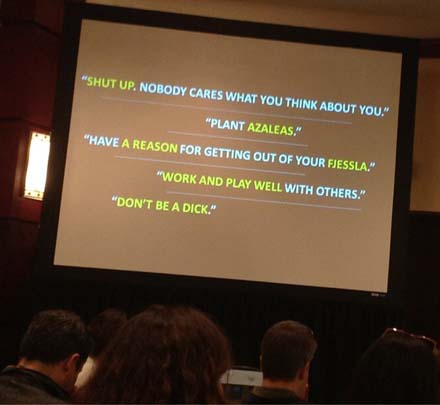Alison Ray at SXSW: Don’t want to scare you all, but we’re not going to have jobs for much longer. At least, not the jobs we have now.

 By Alison Ray at SXSW
By Alison Ray at SXSW
How does it feel to be at SXSW? Among all the creative technologists, marketers, food vans, instigators of innovation, vendors, speakers, mentors, and the dreaded start-ups?
Pretty freakin’ scary if you work in advertising. After today I’m agreeing with the old saying – Don’t tell my mother I’m in advertising. She thinks I play piano in a whore house.
Don’t want to scare you all, but we’re not going to have jobs for much longer. At least, not the jobs we have now.
A million years ago, while in university, I had to debate on the topic “Will the internet kill newspapers?”. Today’s session on “Can’t buy me like” had the same feel to it – the industry, communications, media, brands and customer experiences are changing and the ones who will feel the impact most is us. (For those interested I argued that the internet experience couldn’t replace the authentic Sunday morning experience of reading a paper over a lazy breakfast and coffee. The role might diminish, but there would still be a role. Jobs and Co. have since come up with tablets, which makes my context argument less valid, but it was about 12 years go. If you think to yourself I was still in primary school then, I hate you.)
Bob Garfield @Bobosphere and Doug Levy @douglevy1 have written a book titled “Can’t buy me like”, all about how authentic customer connections drive superior results. They believe that in 2013 if you are blanketing the world with advertising, you haven’t realised how the world has changed. While the industrial revolution emphasised scale, the digital revolution has decimated it.
In the product era, marketers would focus on their products and their features – any colour, as long as it is black. In the 60s we hit the consumer era – where we found out who we were selling to and marketers played to the heart and mind. Here the marketer defined the brand and shaped perception. In this era, the fundamentals were reach, frequency, target audience, influential ads, placed where people would see them. We all know those – we talk them everyday. But Garfield and Levy outline forces that have irrevocably changed this – the collapse of mass media, transparency, social connectivity, and trust.
![image[4].jpg](https://campaignbrief.com/wp-content/uploads/2010/03/image5B45D.jpg) This has given rise to the new era – the relationship era – where people’s experiences have a huge impact. Fundamentals of relationship era marketing are trust, belief, purpose and authenticity. Messages in this era that are just designed to shape perception feel patronising. And the scary thing for us, is that advertising doesn’t work well any more in a social media fragmented world with a Like button.
This has given rise to the new era – the relationship era – where people’s experiences have a huge impact. Fundamentals of relationship era marketing are trust, belief, purpose and authenticity. Messages in this era that are just designed to shape perception feel patronising. And the scary thing for us, is that advertising doesn’t work well any more in a social media fragmented world with a Like button.
 These things – trust, belief, purpose and authenticity – can’t be faked. The two presenters reinforce time and time again that you can buy advertising, but you can’t buy love. You can’t even buy like. But you can earn it. People know when companies are being inauthentic. Engraving the words Integrity, Communication, Respect on your build wall won’t make your company those things – just ask Enron. They suggest these 5 tips (left) for making sure that you are authentic and relevant in this new world.
These things – trust, belief, purpose and authenticity – can’t be faked. The two presenters reinforce time and time again that you can buy advertising, but you can’t buy love. You can’t even buy like. But you can earn it. People know when companies are being inauthentic. Engraving the words Integrity, Communication, Respect on your build wall won’t make your company those things – just ask Enron. They suggest these 5 tips (left) for making sure that you are authentic and relevant in this new world.
These guys gave us numerous examples of “Firms of endearment” who widely outperform other companies. Advertising budgets for unloved and untrusted brands are three times higher. The underlying message: companies that care about something bigger than selling their product sell more of their product.
![image[5].jpg](https://campaignbrief.com/wp-content/uploads/2010/03/image5B55D.jpg) This did make me wonder, is this the wrong topic to be blogging about for Campaign Brief?
This did make me wonder, is this the wrong topic to be blogging about for Campaign Brief?
I don’t think so. I work for a business that has a purpose – to make a difference on our clients’ business. If this is truly our purpose, we will have to continue to evolve and change as both our clients do, and the environment does. We may curate content instead of writing newspaper ads for our clients, but our purpose stays.
This session was so interesting – plus presented so well – that I actually got up to ask a question. I wanted to know how we sell this new concept into not only our marketing clients, but also the board/executive level which is where real change needs to be endorsed.
Bob Garfield’s response? Buy the book. I plan to.
Alison Ray, planning director at The Brand Agency in Perth, Western Australia, is attending SXSW in Austin and reporting exclusively for Campaign Brief.

8 Comments
What these new world marketing “experts” forget is that when, for example, I buy some Jam at the supermarket I don’t really want a “relationship” with the brand and I certainly don’t want a “conversation” with the brand. I don’t want to tweet about it. I don’t want to “engage” with it. I don’t want to visit its website.
I just want them to make good jam.
So sure I’ll pick a jam that seems ‘authentic”. But all I really have to go on, in this example, is packaging and the information on the pack. Oh, and above the line advertising.
I think the idea that advertising doesn’t work on people anymore is vastly over stated. I don’t think it worked very well 20 or 30 years ago. Because most of it was terrible. I mostly never believed advertising unless it was done brilliantly. Then very occasionally I noticed I would like a product and couldn’t really think of any other reason other than their ads gave me a great feeling about the company behind them.
I don’t think that’s changed that much.
Totally agree with you, John. And you, Alison.
See the trick is, as it’s always been, to create popular art in the service of a brand, and to convince those buying it (the client) that it’s based on scientific method.
In the case of your jam example, John, to convince the client that your cut-through ad “establishes a relationship with the consumer based on fun, trust and entertainment.” Or some such shit.
Making the the ads is fucking easy compared with having to justify them to beancounters.
Alison – thanks for the great article! Your comment about your your mom brought a knowing smirk to my face.
John – thanks for the comment. We’re talking about (debating, maybe?!) one of my favorite topics. I agree that few people would want to engage in lots of dialogue about jam or even have a deep relationship with a jam-maker focused solely on the product. One of the examples in our presentation at SXSW (and in the book) is a stick of underarm deodorant, which may be even less intriguing that jam?!). P&G’s Secret has brought more than a million girls and women into a relationship with the brand, or at least a connection with each other supported by the brand. The key is that we go a level deeper than WHAT (the product) to the WHY (purpose) behind the product.
Doug Levy
co-author, Can’t Buy Me Like
I feel it depends on who is buying the jam…
At least this says some promising things about what we think of as ‘conventional’ advertising – part of anyway:
http://www.marketingmag.com.au/news/tv-disruption-looms-prime-time-audience-more-addicted-and-connected-than-ever-before-37471/
It wont be the same but it wont disappear altogether.
Thanks Doug,
Let me just say I probably agree with much of your argument ( I haven’t read your book yet) and I’ve been involved in creating integrated campaigns similar (in strategy) to the Secrets work you mentioned.
I just question how truly effective this new strategy is, where a given brand finds a topic the target audience is interested in (hopefully passionate about) and then effectively sponsors that topic. (Though perhaps it’s the best a brand can hope for in the internet world.)
In the case of Secrets they have focused on bullying which is incredibly resonant with girls (BUT has nothing to do with deodorant). And that’s the trouble – the best the product can hope for is a kind of third party sponsorship effect in terms of their brand.
I mean with P&G Secrets, while all the discussion about saying sorry and regret over bullying other girls played out, how many of these girls actually thought about the product behind it?
(I’m sure there’s some phoney figure about sales increases attached to the case study but really?)
Hats off to the last of the non-anonymous trolls.
Like the ancient Timex, takes a licking and keeps on ticking . . . but why?
Doug- Great example with P&G’s Secret. Nowadays, there are WAY too many choices. The solution lies in marketing your WHY, not your WHAT. I’m not sure if you’ve seen Simon Sinek’s video on “start with why,” but here is the link : http://www.youtube.com/watch?v=OVnN4S52F3k
Basically, it’s about how most brands go from WHAT>HOW>WHY; however, successful brands always start with WHY and work backwards.
Alison- Great post! I envy you for being able to go to SXSW. I think it’s crucial that companies understand that you have to build a relationship with the consumer, not just fake it. When you are genuine, you don’t have to try as hard.
What brand Jam do you buy John Ham?
Did you buy it becuase of that engaging point of sale or was it that radio, print or TVC spot. What persuaded you to buy one brand over another? Oh that rights you were told or recommended to the brand from a friend.
How did that happen again?
Spend 50% on the idea and the 50% on working out how to tell someone about it.
Seriously get with the program make a change and embrace new ways of communication.